Abstract
OBJECTIVES: To evaluate stroke patients' satisfaction with care received and to identify characteristics of patients and care which are associated with patients' dissatisfaction. DESIGN: Cross sectional study. SETTING: Sample of patients who participated in a multicentre study on quality of care in 23 hospitals in the Netherlands. PATIENTS: 327 non-institutionalised patients who had been in hospital six months before because of stroke. MAIN MEASURES: Data were collected on (a) characteristics of patients: socio-demographic status, cognitive function (mini mental state examination), disability (Barthel index), handicap (Rankin scale), emotional distress (emotional behavior subscale of the sickness impact profile) and health perception; (b) characteristics of care: use of various types of formal care after stroke, unmet care demands perceived by patients, unmet care demands confirmed by their general practitioners, continuity of care, and secondary prevention, and (c) patients' satisfaction with care received. RESULTS: 40% of the study sample were dissatisfied with at least one type of care received. Multivariate analyses showed that unmet care demands perceived by patients (odds ratio (OR) 3.2, 95% confidence interval (95% CI) 1.8-5.7) and emotional distress (OR 1.8, 95% CI 1.1-3.0) were the main variable associated with dissatisfaction. CONCLUSIONS: Patients' satisfaction was primarily associated with emotional distress and unmet care demands perceived by patients. No association was found between patients' satisfaction on the one hand and continuity of care or secondary prevention on the other; two care characteristics that are broadly accepted by professional care givers as important indicators of quality of long term care after stroke. IMPLICATIONS: In view of these findings discussion should take place about the relative weight that should be given to patients' satisfaction as an indicator of quality of care, compared with other quality indicators such as continuity of care and technical competence. More research is needed to find which dimensions of quality care are considered the most important by stroke patients and professional care givers.
Full text
PDF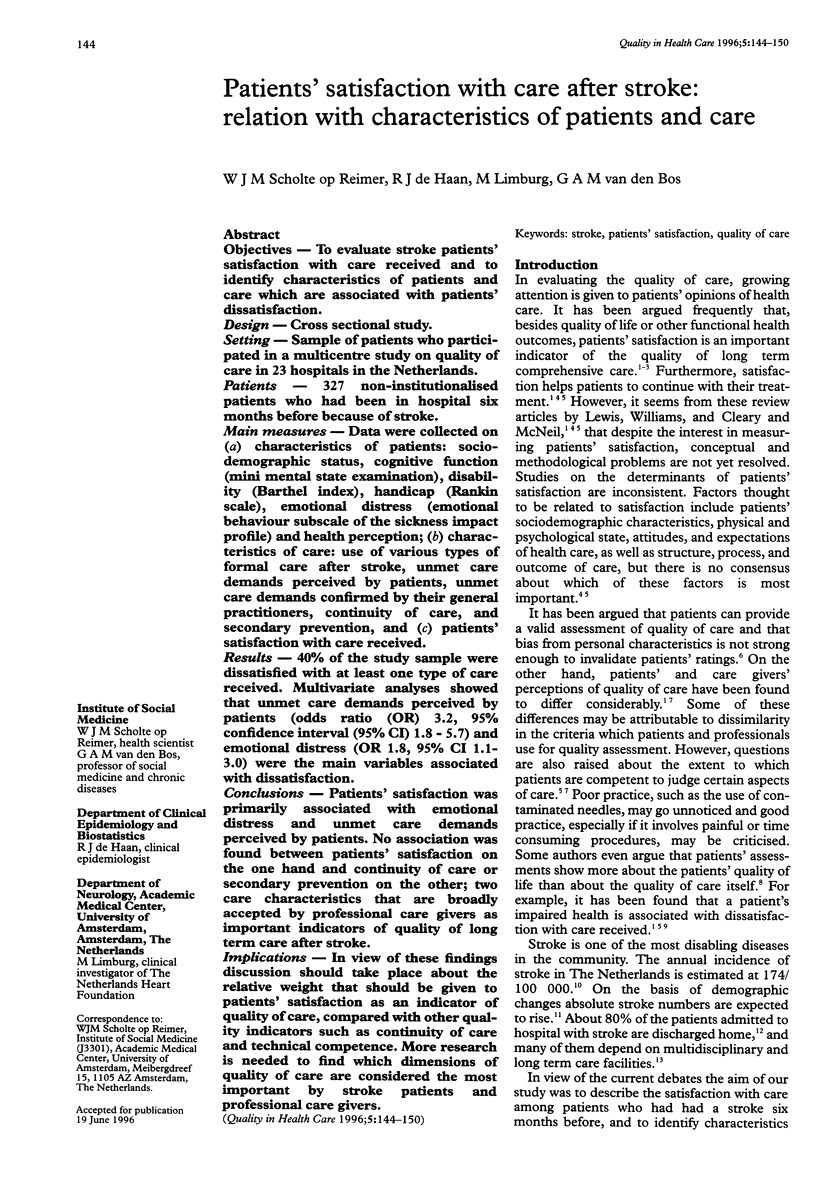
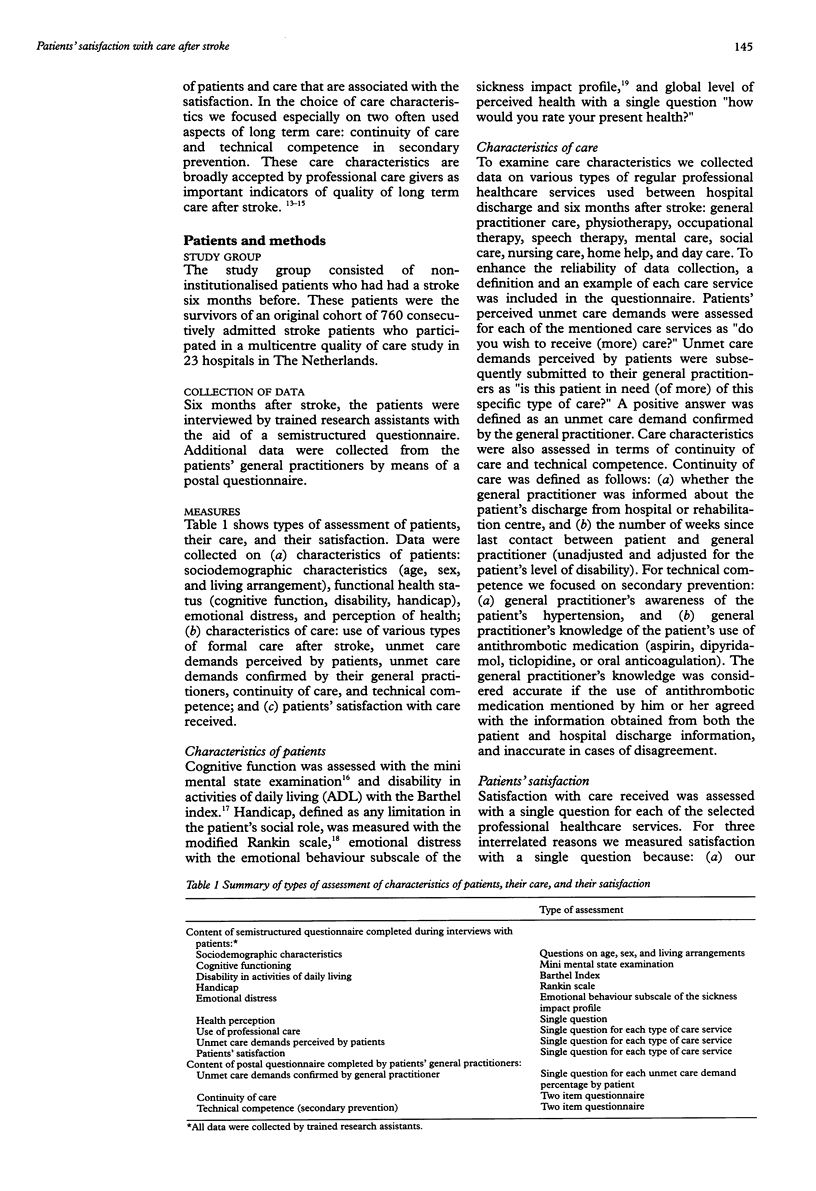
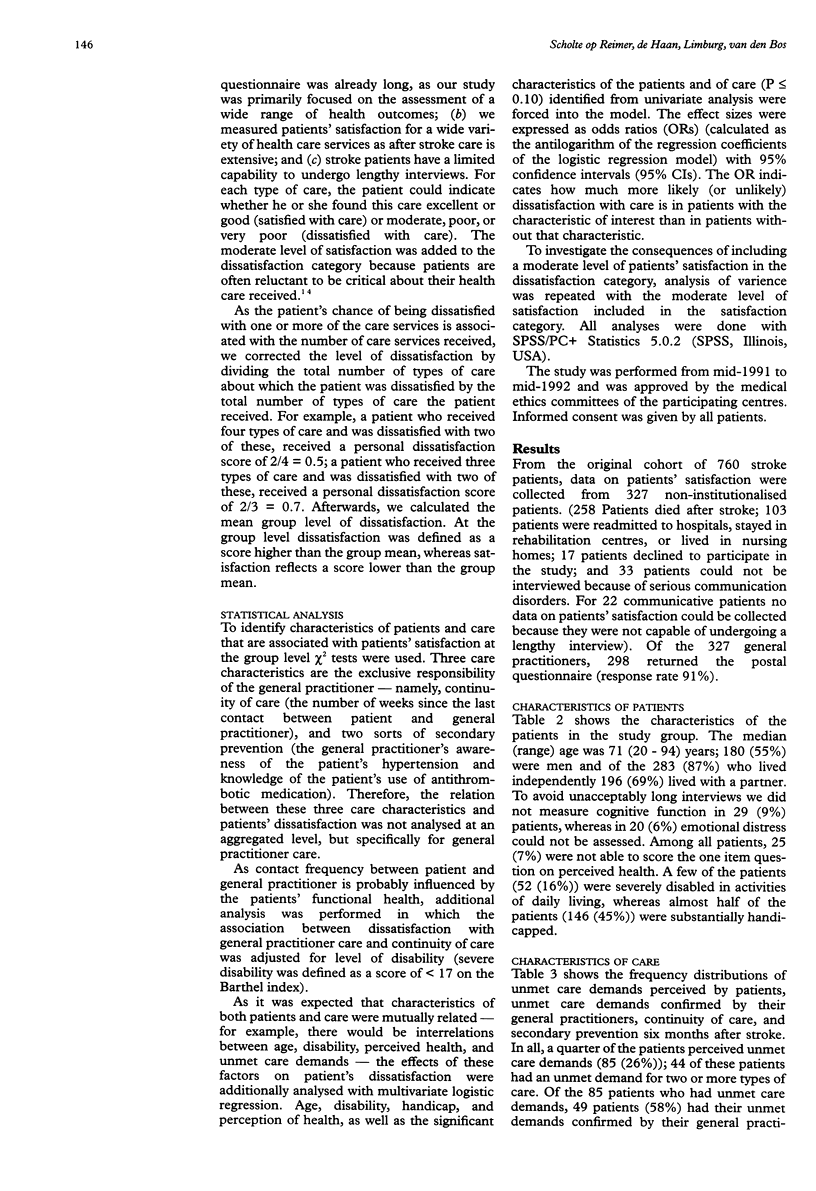
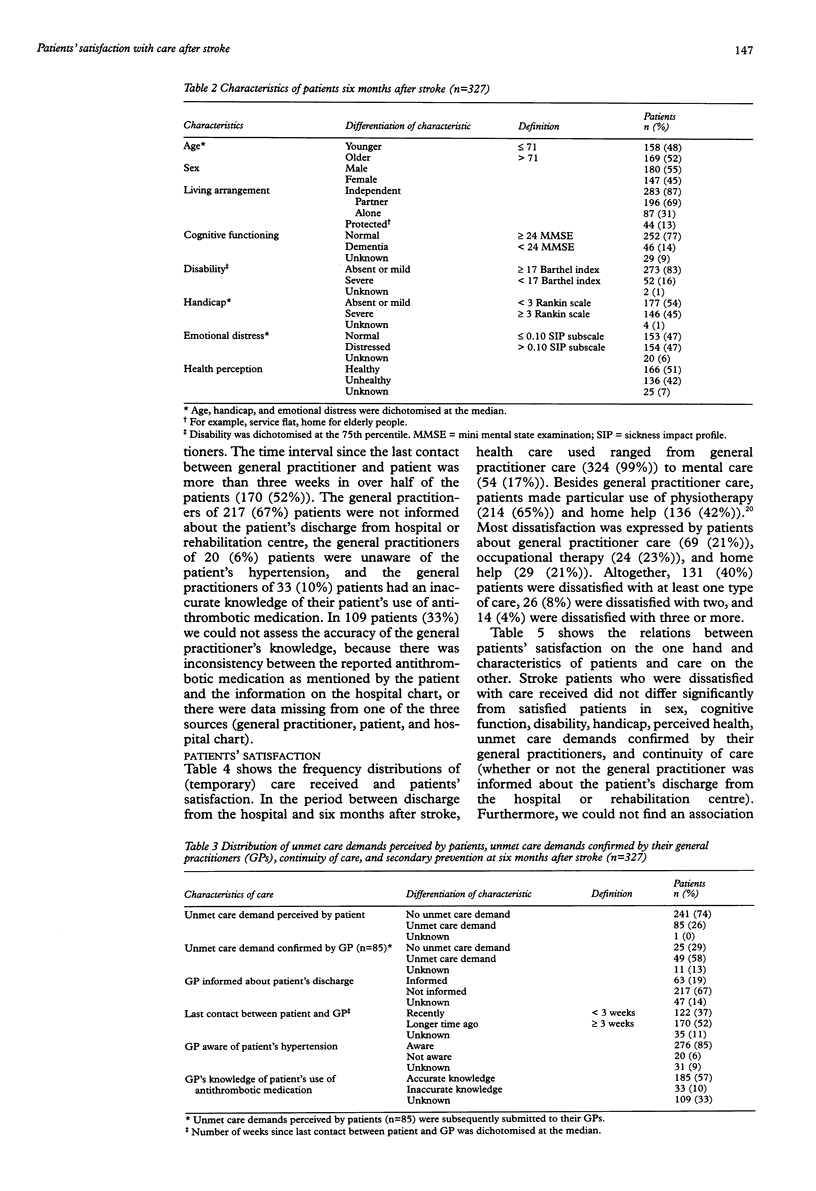
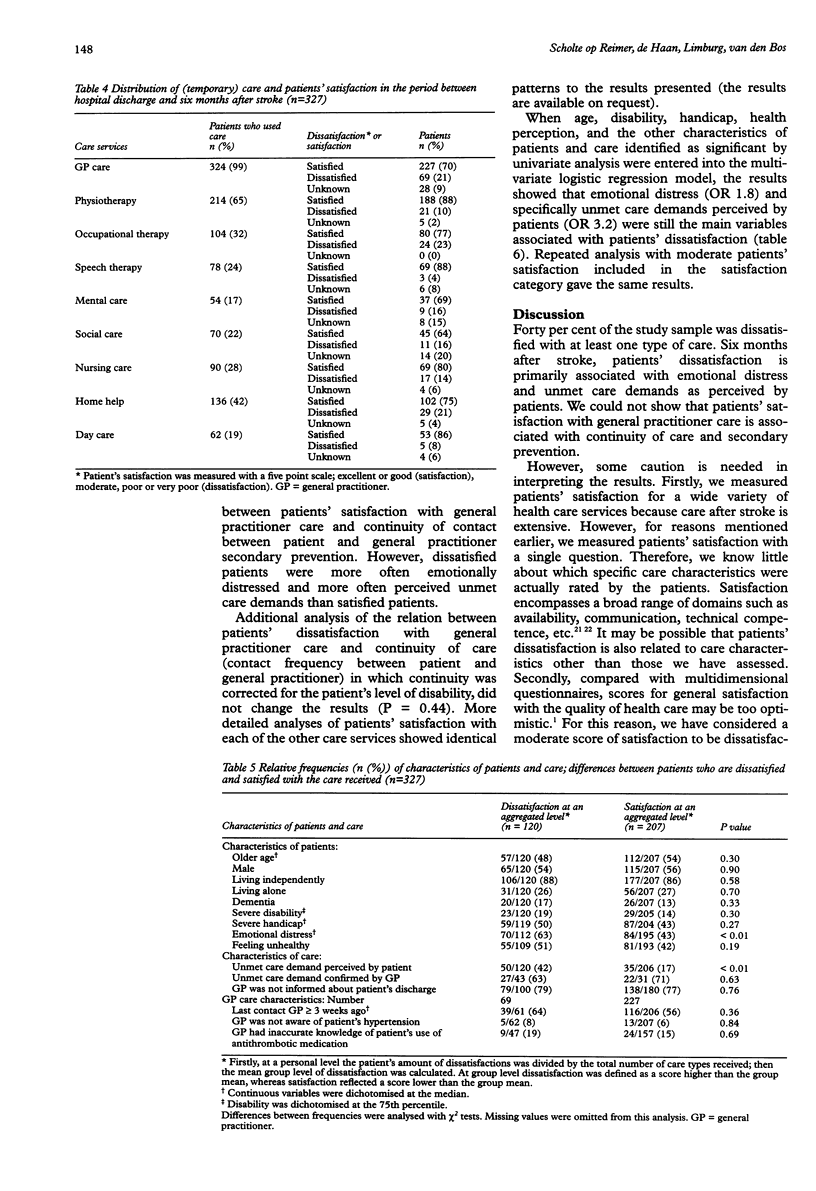

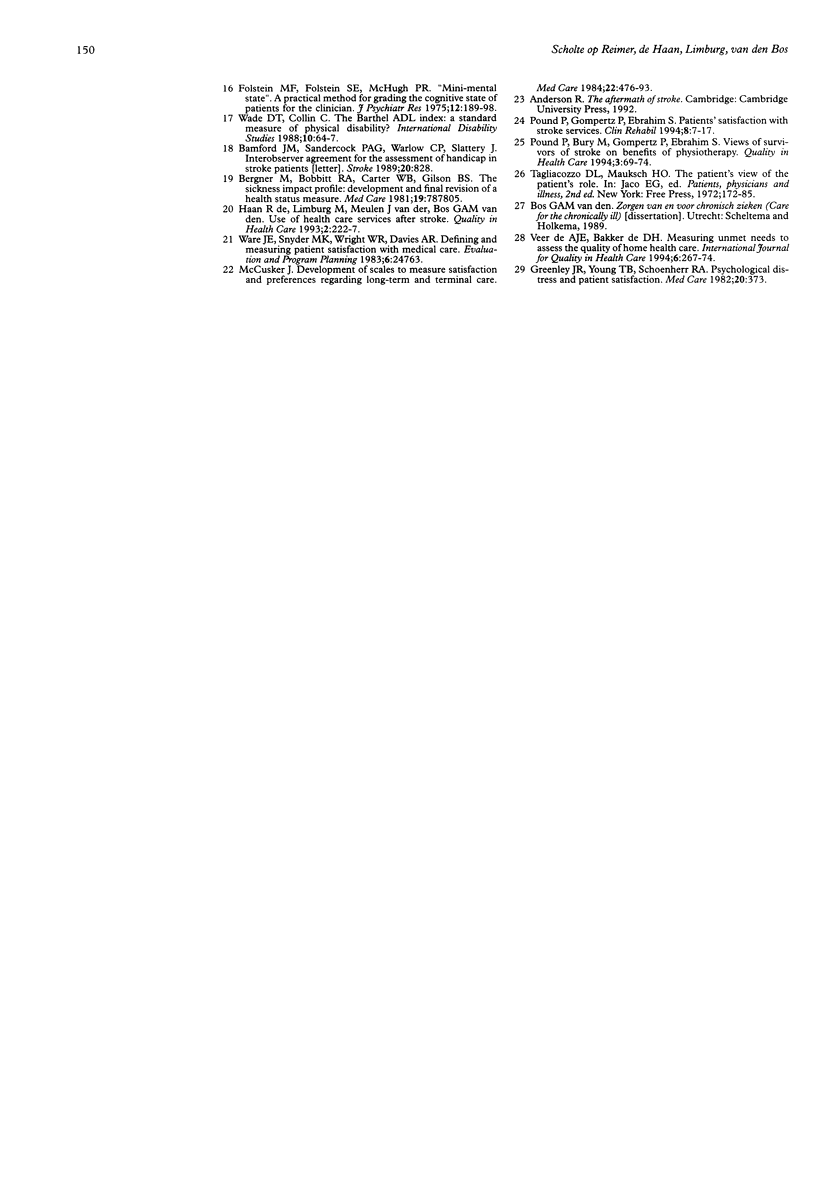
Selected References
These references are in PubMed. This may not be the complete list of references from this article.
- Bamford J. M., Sandercock P. A., Warlow C. P., Slattery J. Interobserver agreement for the assessment of handicap in stroke patients. Stroke. 1989 Jun;20(6):828–828. doi: 10.1161/01.str.20.6.828. [DOI] [PubMed] [Google Scholar]
- Bergner M., Bobbitt R. A., Carter W. B., Gilson B. S. The Sickness Impact Profile: development and final revision of a health status measure. Med Care. 1981 Aug;19(8):787–805. doi: 10.1097/00005650-198108000-00001. [DOI] [PubMed] [Google Scholar]
- Cleary P. D., McNeil B. J. Patient satisfaction as an indicator of quality care. Inquiry. 1988 Spring;25(1):25–36. [PubMed] [Google Scholar]
- Davies A. R., Ware J. E., Jr Involving consumers in quality of care assessment. Health Aff (Millwood) 1988 Spring;7(1):33–48. doi: 10.1377/hlthaff.7.1.33. [DOI] [PubMed] [Google Scholar]
- Ebrahim S., Barer D., Nouri F. An audit of follow-up services for stroke patients after discharge from hospital. Int Disabil Stud. 1987;9(3):103–105. doi: 10.3109/03790798709166332. [DOI] [PubMed] [Google Scholar]
- Folstein M. F., Folstein S. E., McHugh P. R. "Mini-mental state". A practical method for grading the cognitive state of patients for the clinician. J Psychiatr Res. 1975 Nov;12(3):189–198. doi: 10.1016/0022-3956(75)90026-6. [DOI] [PubMed] [Google Scholar]
- Greenley J. R., Young T. B., Schoenherr R. A. Psychological distress and patient satisfaction. Med Care. 1982 Apr;20(4):373–385. doi: 10.1097/00005650-198204000-00003. [DOI] [PubMed] [Google Scholar]
- Hall J. A., Milburn M. A., Epstein A. M. A causal model of health status and satisfaction with medical care. Med Care. 1993 Jan;31(1):84–94. doi: 10.1097/00005650-199301000-00007. [DOI] [PubMed] [Google Scholar]
- Herman B., Leyten A. C., van Luijk J. H., Frenken C. W., Op de Coul A. A., Schulte B. P. Epidemiology of stroke in Tilburg, the Netherlands. The population-based stroke incidence register: 2. Incidence, initial clinical picture and medical care, and three-week case fatality. Stroke. 1982 Sep-Oct;13(5):629–634. doi: 10.1161/01.str.13.5.629. [DOI] [PubMed] [Google Scholar]
- Hjortdahl P., Laerum E. Continuity of care in general practice: effect on patient satisfaction. BMJ. 1992 May 16;304(6837):1287–1290. doi: 10.1136/bmj.304.6837.1287. [DOI] [PMC free article] [PubMed] [Google Scholar]
- Lewis J. R. Patient views on quality care in general practice: literature review. Soc Sci Med. 1994 Sep;39(5):655–670. doi: 10.1016/0277-9536(94)90022-1. [DOI] [PubMed] [Google Scholar]
- Lohr K. N. Outcome measurement: concepts and questions. Inquiry. 1988 Spring;25(1):37–50. [PubMed] [Google Scholar]
- McCusker J. Development of scales to measure satisfaction and preferences regarding long-term and terminal care. Med Care. 1984 May;22(5):476–493. doi: 10.1097/00005650-198405000-00011. [DOI] [PubMed] [Google Scholar]
- Niessen L. W., Barendregt J. J., Bonneux L., Koudstaal P. J. Stroke trends in an aging population. The Technology Assessment Methods Project Team. Stroke. 1993 Jul;24(7):931–939. doi: 10.1161/01.str.24.7.931. [DOI] [PubMed] [Google Scholar]
- Oberst M. T. Methodology in behavioral and psychosocial cancer research. Patients' perceptions of care. Measurement of quality and satisfaction. Cancer. 1984 May 15;53(10 Suppl):2366–2375. [PubMed] [Google Scholar]
- Pound P., Bury M., Gompertz P., Ebrahim S. Views of survivors of stroke on benefits of physiotherapy. Qual Health Care. 1994 Jun;3(2):69–74. doi: 10.1136/qshc.3.2.69. [DOI] [PMC free article] [PubMed] [Google Scholar]
- Sensky T., Catalan J. Asking patients about their treatment. BMJ. 1992 Nov 7;305(6862):1109–1110. doi: 10.1136/bmj.305.6862.1109. [DOI] [PMC free article] [PubMed] [Google Scholar]
- Silliman R. A., Wagner E. H., Fletcher R. H. The social and functional consequences of stroke for elderly patients. Stroke. 1987 Jan-Feb;18(1):200–203. doi: 10.1161/01.str.18.1.200. [DOI] [PubMed] [Google Scholar]
- Wade D. T., Collin C. The Barthel ADL Index: a standard measure of physical disability? Int Disabil Stud. 1988;10(2):64–67. doi: 10.3109/09638288809164105. [DOI] [PubMed] [Google Scholar]
- de Haan R., Limburg M., van der Meulen J., van den Bos G. A. Use of health care services after stroke. Qual Health Care. 1993 Dec;2(4):222–227. doi: 10.1136/qshc.2.4.222. [DOI] [PMC free article] [PubMed] [Google Scholar]
- de Veer A. J., de Bakker D. H. Measuring unmet needs to assess the quality of home health care. Int J Qual Health Care. 1994 Sep;6(3):267–274. doi: 10.1093/intqhc/6.3.267. [DOI] [PubMed] [Google Scholar]


